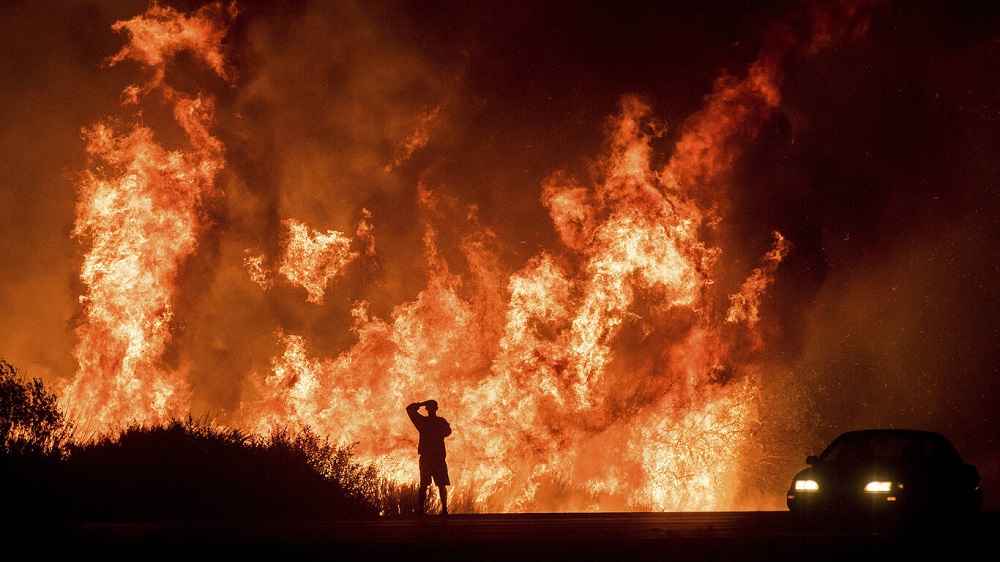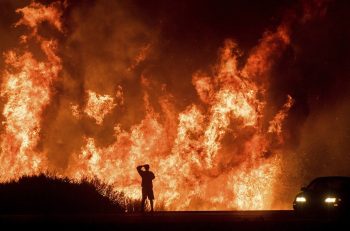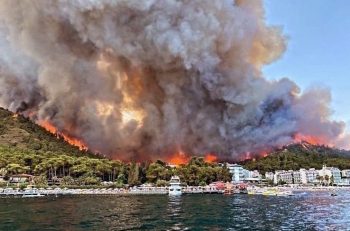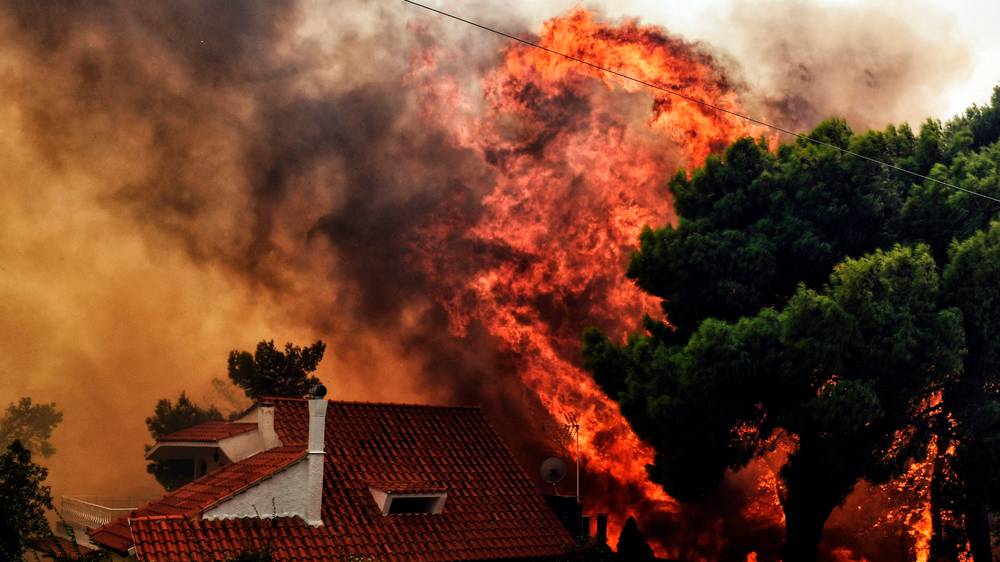‘If The Wrong Practices Continue, The Fires Will Continue to Increase’

‘Conspiracy theories prevent to talk about climate crisis and human-caused problems.’ Turkey left behind a week in the fight against forest fires. We talked to Prof. Dr Doğanay Tolunay, who is a lecturer at Istanbul University-Cerrahpaşa - Faculty of Forestry, about the forest fires, which have tripled in the last 30 years, and the mistakes made in firefighting.
Turkey has been fighting forest fires in the Mediterranean and Aegean regions for a week. According to the statement of General Director of General Directorate of Forestry, Bekir Karacabey, a total of 144 forest fires were detected in different provinces of Turkey in six days. According to the current data shared by the Ministry of Agriculture and Forestry, there are currently two fires in Antalya, five in Muğla and one in Isparta.
‘No Progress Has Been Made After The 2019 İzmir Fire’
Prof. Dr. Doğanay Tolunay, together with four academics during the forest fires in İzmir, which took days to extinguish in 2019, published a statement to correct the established erroneous information about forest fires.
While Tolunay gave information about the content of the declaration they published while the İzmir fires were taking place, he also explained what wrong practices and information pollution continue regarding forest fires: ‘The İzmir fire in August 2019 lasted for days, allegations were made that the fire was caused by sabotage, it was discussed why the THK (Turkish Air Force) planes were not used to extinguish the fire, and they were allegations like the burning forests would be zoned for construction. There was an incredible amount of information pollution in the public. Thereupon, together with our professors such as Prof. Dr. Ünal Akkemik, Assoc. Prof. Dr. Cihan Erdönmez from Istanbul University-Cerrahpaşa – Faculty of Forestry, Prof. Dr. Erdoğan Atmış from Bartın University – Faculty of Forestry and Assoc. Prof. Dr. Oğuz Kurdoğlu from Karadeniz Technical University – Faculty of Forestry, we published a declaration called “The Call of the Forest”. In the declaration, we drew attention to the mistakes made by the Ministry of Agriculture and Forestry, General Directorate of Forestry, Universities, NGOs and the public about forest fires and listed the things that should be done. I can say that unfortunately nothing has changed in the intervening two years, and we have not made any progress.’
Compiled from forestry statistics of the general directorate of forestry (OGM)
Reasons of the forest fires (average number of fires per year between 2013 – 2020): Natural(lightning), stubble fire, dump, hunting, shepherd fire, cigarettes, picnic, other negligence-accidents, terror, incension, expanding, other intentions, energy, traffic, other accidents, unknown reasons]
Featured Topics in The Call of the Forest’ Declaration
The topics that Tolunay and other academics focused on in their ‘The Call of the Forest’ declaration they published are as follows:
- Policies that harm forests need to be abandoned.
- Forestry professional organizations should not be in the control of politics.
- Academia should not stay silent and be speechless.
- Non-governmental organizations and nature lovers should criticize and express their opinions based on scientific knowledge.
- The General Directorate of Forestry should provide an effective, fast and satisfactory information flow without leaving any question marks in the minds and should not make excuses for transparency.
- Non-forestry practices allocated to facilities such as mining, tourism, infrastructure, etc., which reach 700 thousand hectares (738 thousand hectares today), are the cause of the fragmentation of forests and the biggest cause of forest destruction.
- Reforestation of burned forest areas is a requirement of the Constitution, and it is a constitutional right for citizens who suspect otherwise to obtain information from the relevant forestry units and to take legal action if they are not satisfied.
- Instead of hastily afforestation of the burned areas, methods that will enable the natural tree species in the region to be rejuvenated with seeds should be implemented.
‘We Couldn’t Explain That a Forest Ecosystem Can’t Be Created by Planting Trees’
Prof. Dr. Tolunay said that it is not right to call for planting saplings in burned areas after every fire, and that the forest ecosystem does not consist of only trees. ‘We could not explain that what is lost is an ecosystem, both by fires and other practices that damage the forests, and that a forest ecosystem cannot be created by planting trees (in fact saplings).’ Tolunay underlined that another possibility is that the decision-makers do not want to understand this. However, Tolunay, who mentioned that it is the duty of scientists to explain until they are understood, said ‘The forest is an ecosystem and does not consist of only trees. It contains hundreds of creatures. With fires and other ecosystem destructions, these living things and even the non-living things that form the ecosystem are also damaged. After such destruction, the main thing is to restore the ecosystem’.
‘Red Pine and Maqui Can Re-exist After the Fire’
Stating that forest fires occur mostly in the Aegean and Mediterranean Regions in our country, Tolunay informed that the forest assets in this region are compatible with being able to come back to life after the fire: ‘The total forest area of our country is 22.9 million ha. 5.9 million ha of this consists of oak forests and 5.6 million ha of red pine forests. Red pine is the second most widespread species in our country and is completely natural. The natural vegetation of our Aegean and Mediterranean regions is red pine and maquis. Red pine forests and maquis species existed in this geography before humans. All the fires, of which 89 percent are man-made today, were natural before humans. Red pine forests and maquis had adapted to the fire to rejuvenate. Cones of red pine trees do not fall from the tree and are not damaged much by fire. After the fire, it falls into the ash on the soil and germinates the next spring and develops its roots in the soil. In the absence of fire, the seeds fall into a thick layer of dry leaves on the soil but cannot germinate. On the other hand, only the stems and shoots of the maquis plant species are burned in the fire, and their roots are not damaged. For this reason, both the red pine saplings and the scrub cover come back to the burned areas in the spring months after the fire. If we copy from this ecological cycle, it is possible to regain the lost vegetation in red pine and scrub. Afforestation should be considered in areas where saplings and other herbaceous and shrub species do not come a year later.’
‘Forest Fires Have Increased 3 Times in the Last 30 Years’
Stating that forest fires in Turkey have increased 3 times in the last 30 years, Tolunay mentioned that the biggest reason for this is the increase in human forest interaction. According to Tolunay, who says that the increase in facilities and settlements in the forest directly affects forest fires, the increase in the non-forest practices allowed within the forest areas is also among the factors that increase the danger. By saying ‘Permits for non-forestry uses do more damage to our forests than forest fires. While an average of 9,166 ha of forest fires occurs annually, the average annual permit amount from forests is 29,199 hectares. Only in the last 9 years, 342,845 hectares of forest area have been taken out of the forest as public interest. The public is extremely sensitive to forest fires. However, it should not be overlooked that the permissions given from the forests by saying that there is a public interest,’ Tolunay also drew attention to this danger.
As an example of non-forest practices, he counted power lines, mines, dumps, roads. He said that especially electricity transmission lines are in the top three, along with burning stubble and cigarette, which are among the factors that cause fires.
(burning/allowed forest area)
comparison of forests and burnt areas with granted permits (ha)
- permits for other area uses in the forest (ha)
- burning area (ha)
Source: It is taken from The General Directorate of Forestry Strategic Plans and Forestry Statistics
‘People should be warned against fires in spring’
Tolunay listed a number of measures to prevent the increasing graph of forest fires from year to year: ‘The strategy of the General Directorate of Forestry in fighting the fire is based on extinguishing the fire as soon as possible after it breaks out. But, when you intervene in a fire late, the amount of burned forest area increases. However, if the focus is on reducing the number of fires, the number of burning forests will also decrease. For this reason, the number of fires will decrease even if the public awareness is raised from the spring months, measures are taken to burn stubble and barbecue that cause fires, the facilities in the forest and especially the electricity transmission lines are inspected, and the entrance and exit to the forest is prohibited in July, August and September when the fire risk increases. On the other hand, the fact that the number of helicopters does not increase while the forest fires increase, the number of aircraft is quite limited and the number of personnel in the fire response teams, which are more effective than these two, is also an important shortcoming.”
‘Conspiracy Theories Prevent to Talk about Climate Crisis and Human-Caused Problems’
Stating that there is no awareness of the effects of climate change on the number and size of forest fires, Tolunay emphasizes that conspiracy theories actually precede the factors that need to be tackled: ‘When a fire breaks out in several places at the same time, it is also overlooked that people go into the forest more, barbecue is lit under almost every tree, or that even the most conscious of us throw their cigarettes out of their car windows. When this happens, the first thing that comes to mind is sabotage. However, we do not know that the increased temperatures with climate change make grass and bushes dry, the leaves of trees decrease in water cornet even if they do not dry, and they become ready to ignite easily. Especially when there are heatwaves, the risk of fire increases and the smallest spark turns into a fire. While not only our country but also all Mediterranean countries and even northern European countries are fighting fires at the same time, conspiracy theories prevent discussion of not only the effects of climate change but also the deficiencies in the fight against fires. Even if the relationships between climate change and forest fires are discussed, I think that this discussion will result in the scapegoat of climate change due to the deficiencies in the fight against fires. It is also the same with the floods, and unfortunately, it is said “it has been the heaviest rainfall in the last 500 years, what should we do?”’






Bizi Takip Edin